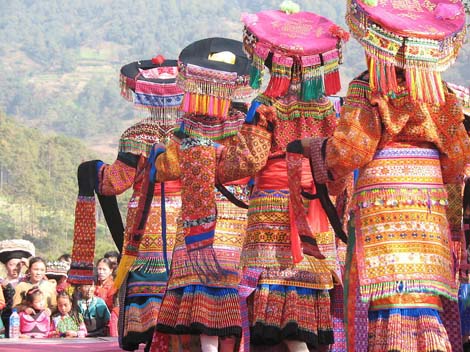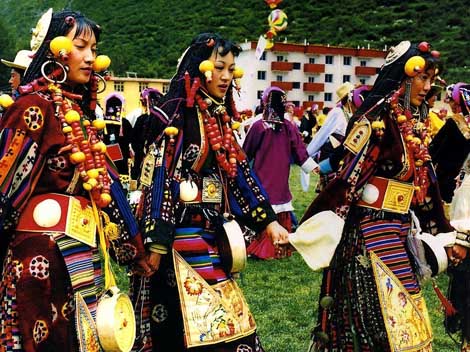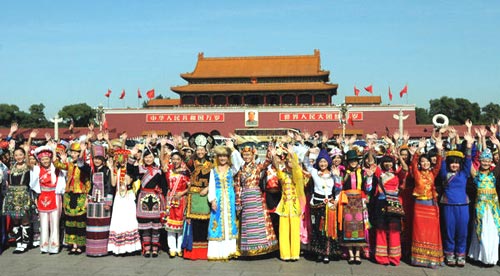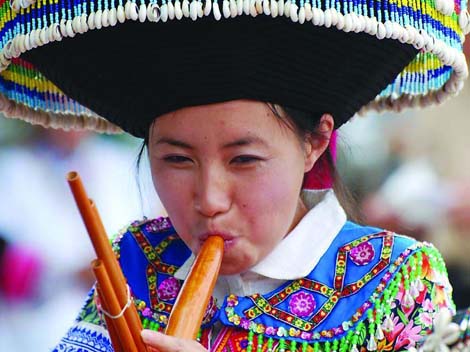
Clothes of Chinese ethnic minorities are flowery and colorful, extremely exquisite, and highly characteristic. They constitute an important part of the rich history and culture of the nationalities.

Every aspect of their garments, such as raw materials, textile technology, fashion and decoration, retains a distinct character of the nationality and the locality. The Mongolians, Tibetans, Kazakstans, Khalkhases, Yugurs, etc., who are mainly engaged in stockbreeding, make their apparel mostly from animal skin and hair. On the other hand, farming ethnic minorities usually take the locally produced cotton or hemp thread as raw material to spin cloth and silk and make clothes.

Ethnic minorities' techniques of spinning and weaving, tanning, felting and so on have undergone a long history. There are numerous designs and forms in the clothing of Chinese ethnic minorities. On broad lines, they can be classified into two types: long gowns and short clothes. Those who are in gown usually wear a hat on the head and boots on the feet while those who are in short clothes usually wear a handkerchief and shoes. The forms of the gowns are various too: the high-collar and big-front type worn by the Mongolian, the Man, the Tu and so on; the collarless tilted-front type worn by the Tibetan, the Moinba and so on; the tilted-front type worn by the Uygur and other nationalities; the kanjian-type long gown...As for short clothes, they fall into the following two types: trousers and skirts.

In the fashions of skirts, there are pleat skirt, tube skirt, short skirt, one-piece and so on. In any kind of clothes, the gown, the coat, the skirt, or the trousers, different nationalities vary in their structure, technique, style and any other aspect. For example, high-collared big gowns fall into many types: those with a vent and those without a vent, those with vents both in front and in back, those with front and back vents and edging all around, and so on.
Garments of ethnic minorities vary greatly not only with different nationalities, but also with different branches and different regions within the same nationality. Difference can be seen from province to province, from county to county, and even from village to village: just like a hundred flowers in bloom. The garment is the most obvious mark of the nationality, and in history, many nationalities were named just according to their garments.
In a country like China, with such a vast land, so many nationalities and an unbalanced social development, different economic lives, cultural levels, natural environments and geographical conditions and climatic conditions have led to the great variety of clothes, which should be said to be one of the characteristic points of folk garments.
Some techniques of Chinese ethnic minorities such as embroidery, batik and so on, are very developed, and are widely used in their clothing adornments, which is another feature of their garments.
Because of relatively plain design and structure of traditional Chinese clothing, embroidered edgings, decorated bands, draped cloth or silks, patterns on the shoulders, and sashes were often added as ornamentation. These varied designs came to be one of the unique features of traditional Chinese dress.
Darker colors were much more favored than lighter ones in traditional Chinese clothing so the main color of ceremonial clothing tended to be dark while bright, elaborate tapestry designs accented. Lighter colored clothing was worn more frequently by the common people for everyday use.
The Chinese associate certain colors with specific seasons: green represents spring, red symbolizes summer, white represents autumn, and black symbolizes winter. The Chinese are said to have a fully developed system of matching, coordinating, and contrasting colors and shades of light and dark in apparel.
Red is favorite for most Chinese people since Red symbolizes good luck in traditional mind. Chinese people prefer to wear in red when they are celebrating some important festivals or events in their life, such as wedding ceremony.
The Han nationality is the most populous nationality both in China and in the world. Its history is of long standing and its culture is resplendent. From the history of thousands of years,you may see there are chiefly two basic forms in design of the clothing of the Han nationality: the upper coat plus the lower skirt, and the combination between the coat and the skirt; the dajin(front of a Chinese garment which buttons on the right) has remained to be the most striking feature.
The main raw materials of Han clothes include flax, silk, cotton, woolen cloth, leather and so on. The products of dyeing and weaving of the Han nationality are unique in the world and enjoy a high reputation for their long history, advanced technology and elegant fashioning. For quite a long time in history, the dyeing and weaving technology,especially in silk weaving,could not be found elsewhere in the world.
The ancient staining technique of China was very superb and advanced,too: not only the colors were many and gorgeous, but the dyeing was fast, not easy to wade. Thus, it was called the mystical"Chinese art"by Westerners. The methods are roughly classified into the four types: inweaving, dye printing, embroidery and pattern drawing.
After the Revolution of 1911, the chief types of clothes of the male of the Han nationality were changpao(long gown) plus magua(mandarin jacket), changpao plus kanjian(sleeveless jacket), Sun Yat Sen's uniform, school wear and western-style clothes, etc. On the other hand, Chinese-style shan'ao(coat) and mindangku (trousers with the waist tucked together without button) were the major garments of the laboring people. Such a difference resulted from different economic conditions and ways of life.
In that period, women's clothes were chiefly qipao, kanjian, upper coat with lower skirt, and trousers.




